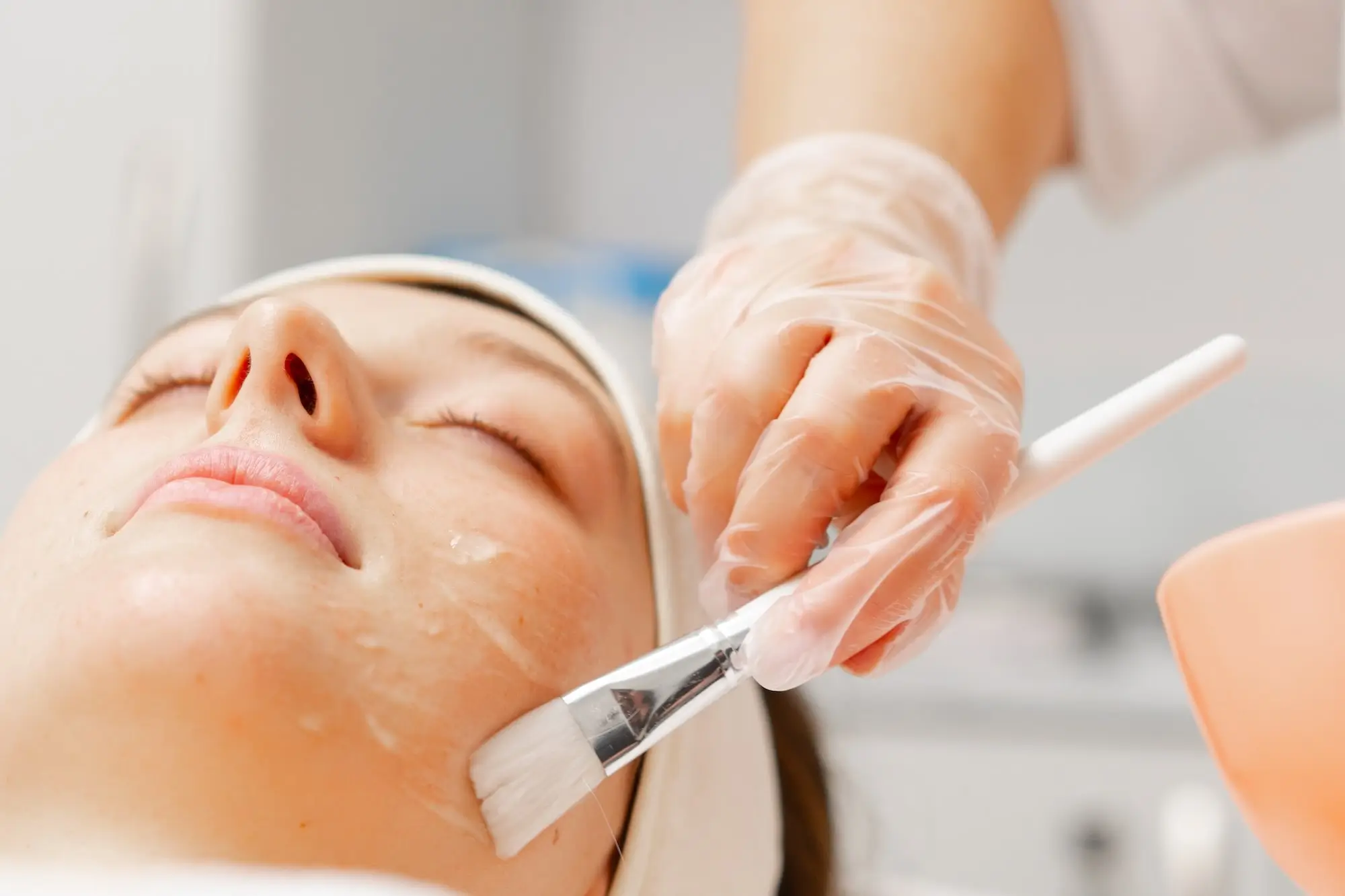You’ve probably heard of glycolic and lactic acid peels, two great options for exfoliating, brightening, and smoothing your skin. But there’s another option worth exploring: mandelic acid.
While it may not be as well-known, it’s one of the most skin-friendly peels out there. If you’ve got sensitive or acne-prone skin, or you’re dealing with rosacea or dark spots, a mandelic acid peel could be just what your skin needs.
| Acid Type | Strength | Best For | Irritation Risk | Penetration |
| Mandelic Acid | Gentle | Sensitive, acne-prone skin | Low | Slow |
| Glycolic Acid | Strong | Aging, fine lines, dull skin | High | Fast |
| Lactic Acid | Mild | Dry skin, uneven texture | Moderate | Medium |
What Is Mandelic Acid?

Mandelic acid belongs to the alpha-hydroxy acid (AHA) family of chemical compounds. The name comes from substituting a carboxylic acid (-COOH) on the adjacent carbon in the alpha position with a hydroxyl group (-OH).
AHAs can be synthesized (man-made in a laboratory), but are naturally occurring and can be derived from fruit and milk sugars. Mandelic acid, for example, can be extracted from apples, bitter almonds, and wild cherries.
Benefits of Mandelic Acid Peel
Mandelic acid peels can:
- Reduce acne and clogged pores
- Minimize hyperpigmentation and dark spots
- Brighten uneven skin tone without causing irritation
- Help manage rosacea symptoms gently and effectively
- Stimulate collagen to improve skin texture and firmness
Whether you’re considering mandelic acid for hyperpigmentation, dark spots, or mandelic acid rosacea care, this treatment offers visible results with less risk of redness.
For Which Skin Types Is Mandelic Acid Suitable?
Mandelic acid is an excellent choice for people with sensitive or reactive skin. Because it penetrates slowly and works gently, it’s less likely to cause irritation compared to other exfoliating acids. It’s often recommended for those with:
- Rosacea
- Acne-prone skin
- Uneven skin tone or texture
- Post-inflammatory hyperpigmentation
Unlike more aggressive chemical peels, mandelic acid doesn’t inflame the skin. That’s why it’s often used on darker skin tones or by those who struggle with redness or flare-ups from other treatments.
Does Mandelic Acid Peel Skin?

Since mandelic peels are mild, they don’t normally result in the typical skin peeling effect. The results, however, are still there.
You may feel a bit of warmth, tingling, or light irritation, but proper discomfort is rare. Your skin will feel calmer and smoother once it’s removed and after applying the moisturizing cream.
How Often Can I Use Mandelic Acid Peel?
Everyone’s skin reacts differently to AHAs and other exfoliating skin ingredients, regardless of how gentle mandelic acid is for the skin. If you have sensitive skin, the best way is to incorporate mandelic acid gradually.
Mandelic acid peels are primarily for treating rosacea and sensitive skin types, so this is a peel we only do in the office, and it’s not typically recommended for at-home use. The treatment is usually done in a series of three sessions spaced one month apart.
Who Should Avoid Mandelic Acid?
- People with nut allergies, since it’s derived from bitter almonds.
- Anyone with broken skin or open wounds in the treatment area.
- Pregnant or breastfeeding? Speak with your provider before treatment.
Higher strength concentrations (like 40% mandelic acid) should only be used by a dermatologist or qualified provider. If you have cold-sore-prone skin, it can cause outbreaks; your dermatologist can prescribe antiviral medications to prevent this.
How Long Can Mandelic Acid Be Left On?

The skin is cleansed before the mandelic acid peel, and then a toner is applied to remove any remaining natural oils. This degreasing process helps ensure the peel’s effectiveness.
After applying the skin peel with gentle brush strokes, it should be left on the skin for 5–10 minutes. Some formulas may stay on up to 20 minutes. This might seem to be a long time, but because mandelic acid penetrates the skin more slowly, it takes longer to reach the areas where it is needed.
Treatment length varies slightly depending on the mandelic acid-containing formula used. Exfoliating toners and serums are the most commonly used products, but there are many more types. Each one differs in concentration and will have its own guidelines for time.
How Long Does Mandelic Acid Peel Take to Work?
Once cell turnover kicks in and the acid starts to resurface your skin, you can expect to see initial results like smoother skin within a few days. Breakouts can be reduced in as little as 1–2 weeks, and stubborn dark spots can fade in as little as 4–8 weeks. It’s worth noting that the results will improve if you’re consistent and apply SPF every morning.
You may notice softer, brighter skin within a few days, with continued improvement over the following week. A full series of peels (every two weeks if tolerated) is recommended for acne and pigmentation concerns.
Post-Treatment Care Tips
- Use SPF 30 or higher daily
- Avoid direct sunlight for 3–5 days
- No exfoliants or retinoids for a week
- Use barrier-repair moisturizing cream
Why Choose SCCSNJ for Mandelic Acid Peels?

At SCCSNJ, our licensed dermatologists take a holistic approach to skin health. We tailor every peel to your specific skin concerns, whether you’re dealing with acne, rosacea, or dullness.
From our advanced facility in Edison, NJ, we offer safe, medically guided treatments in a calm, supportive environment. With a team that blends experience and compassion, you’re in expert hands.
FAQs
What is mandelic acid best used for?
Mandelic acid helps reduce acne, fade dark spots, and gently exfoliate sensitive or rosacea-prone skin.
How long does a mandelic acid peel appointment take?
The entire treatment takes about 30 minutes, including prep and post-care.
How soon before an event should I get a mandelic acid peel?
Schedule your peel at least 5–7 days before an event to allow for full recovery and glow.
What should I avoid before getting a mandelic acid peel?
Avoid using retinoids, exfoliants, or any other active skincare products for 3–5 days before your appointment.
Can I wear makeup after a mandelic acid peel?
It’s best to wait 24 hours before applying makeup to let your skin breathe and heal.
Can men get mandelic acid peels?
Absolutely. Mandelic acid peels are suitable for all genders and all skin types.
How often should I get a mandelic acid peel for best results?
We recommend a series of three sessions, spaced about one month apart, for optimal improvement.
Is mandelic acid better than salicylic acid for acne?
Mandelic acid is gentler and better for sensitive skin, while salicylic acid is stronger and penetrates oil more deeply.
How is mandelic acid different from glycolic and lactic acid?
It has a larger molecule, so it penetrates more slowly and causes less irritation, perfect for sensitive skin.

